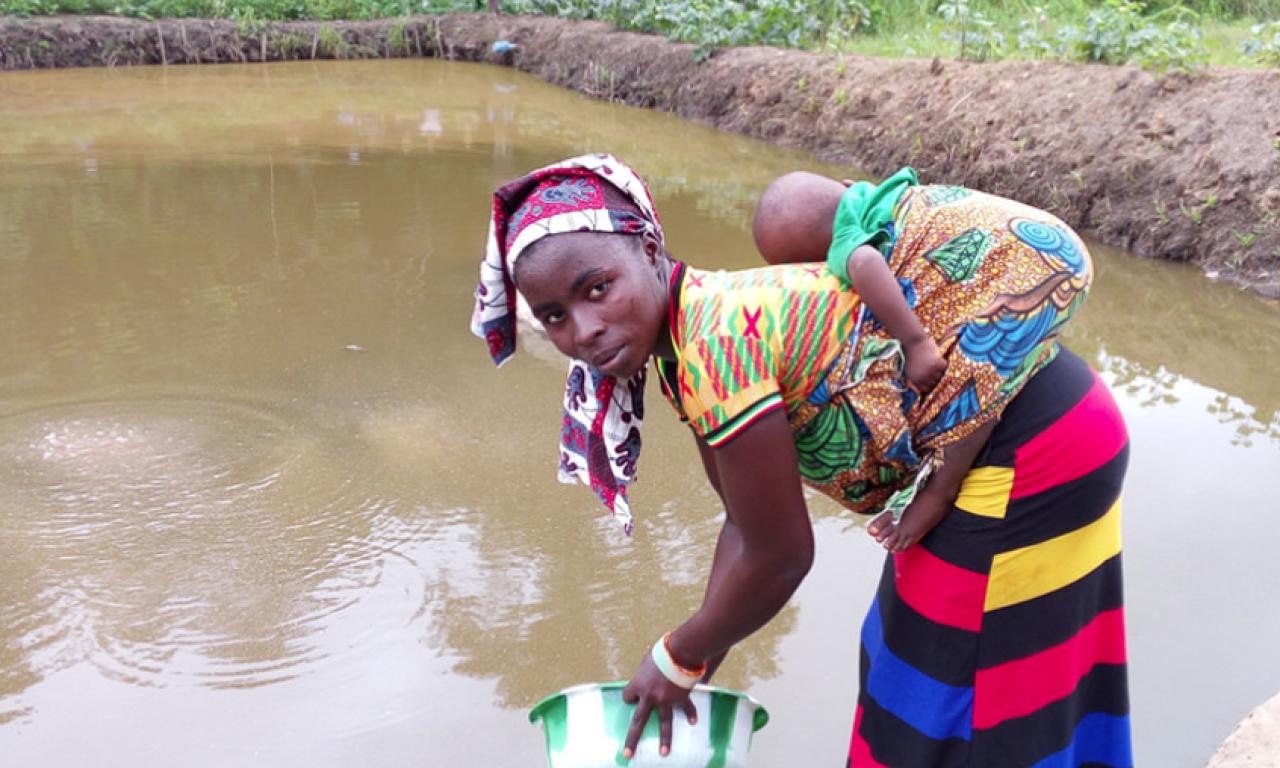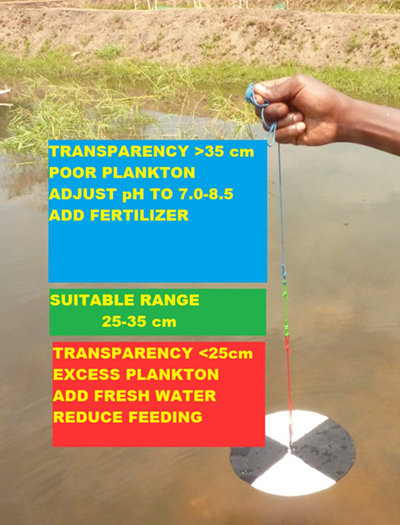
A modified Secchi disk to measure water transparency in fishponds and determine the amount of plankton is helping smallholders in Sierra Leone to farm fish as part of profit-oriented agribusinesses.
Recommended publications
- Food and nutrition security in Sierra Leone with a focus on fish in Tonkolili district
- Sierra Leone fish value chain with special emphasis on Tonkolili district
- Feed the Future Sierra Leone Scaling Up Aquaculture Production (SAP)
A modified Secchi disk to measure water transparency in fishponds and determine the amount of plankton is helping smallholders in Sierra Leone to farm fish as part of profit-oriented agribusinesses.
The Feed the Future Scaling Up Aquaculture Production (SAP) project promotes the development of the aquaculture sector in Sierra Leone to increase fish production, consumption and the incomes of small-scale farmers. Funded by USAID and led by WorldFish as part of the CGIAR Research Program on Fish Agri-Food Systems (FISH), the project focuses on Tonkolili district, one of the poorest and most nutritionally-insecure regions in the country where fish supply is inconsistent and the fish that is supplied is often of poor quality and hygiene. A key project focus is supporting smallholders to farm fish profitably, in parallel with improving input supply, such as lime, fertilizer and feed, and market linkages.
Mabinty Sankoh, Osman Kargbo and Alie Kamara are three of the fish farmers in Matele Bana who have built fishponds with technical support provided by the project. They initially stocked their ponds with over 3200 tilapia fingerlings and learned how to use a modified Secchi disk to monitor water conditions and guide pond-management decisions.
A Secchi disk is a standard tool used to measure water transparency in fishponds to determine the amount of plankton. Plankton causes the water to turn green and serves as natural food for the fish. The disk, which consists of a circular plate painted with alternating black and white quadrants, is typically mounted on a numerically graduated string and lowered into the water. The depth at which it is no longer possible to tell the difference between the black and white parts of the disk is taken as a measure of the transparency of the water.
Modified Secchi disk for local needs

Farmers with low or no numeracy skills are unable to take or interpret the traditional reading. As a result, the version used in Sierra Leone was modified to ensure farmers, regardless of their education level, could benefit from the technology.
The numerically graduated string was replaced with a color-coded string that farmers use to differentiate the various levels of transparency and availability of plankton according to depth. The modified technology is inexpensive, easy to use and made using locally-available materials.
More than 100 farmers working with the SAP project have been trained on the importance of using a Secchi disk during fish production, and have learned how to interpret the color code to determine the abundance of plankton in their pond water.
Importantly, farmers have learned what actions to take when the water transparency of their ponds reaches each color, as indicated by the following:
- If the blue section of the string is in the water and the black and white areas of the disk are still visible, then plankton levels are low and the pH needs to be adjusted to 7.0–8.5 by adding lime followed by fertilizer to help plankton bloom.
- If the green section of the string is in the water and the black and white areas of the disk are not clearly distinguishable, then the plankton level is in the normal range and the pond has healthy bloom. No action or fertilizer is needed.
- If the red section of the string is in the water and the black and white areas of the disk are not clear, then there is too much plankton. Fertilization should be stopped, fresh water added and feeding reduced.
The modified Secchi disk has helped farmers to learn about water management in fish farming and make their own weekly decisions as to whether or not the water in their ponds is in good condition for fish health and growth.
“The Secchi disk has been very helpful not just to us as farmers but also to the other household members as it helps us to decide if the pond water is green or not,” says Mabinty Sankoh. “The colors in the string help us to determine when to add fertilizer to the pond.”
Scaling up learning
The same modified Secchi disk technology was introduced to fish farmers in Zambia’s Northern Province in early 2017 during fish feed trials. It was used to assess water quality in the improved feed trials as an appropriate tool for use with smallholders, and especially those who are numerically illiterate. Farmers monitored the water quality of their ponds on a monthly basis and adjusted the levels of organic matter (e.g. animal manure) applied to their ponds according to the color sections of the string.
In collaboration with INGENEAS, the SAP project produced three videos on the use of the modified Secchi disk as well as good pond management (specifically testing for pH) and developing fish marketing plans. Available in English and Temne, the videos will be incorporated into farmer learning and extension activities. They have also been posted on Agtube, a video-sharing platform established by Access Agriculture to encourage the use of training videos to help farmers, pastoralists and rural businesses improve their profits and livelihoods.